Step-by-step guide to starting a men’s group
Starting one has been one of the most effective steps I’ve taken to improve my life.
Here’s a free version of my “Advice from a therapist” bonus posts for paid subscribers. If you upgrade your subscription ($5/month), you’ll get a bonus post like this most weeks (when I’m not too burned out from seeing therapy clients).
Anyone can ask me questions about relationships, masculinity, mental health, therapy, anything... Reply to this email (even if you’re not a paid subscriber) and I’ll send you my thoughts directly. I might also feature your question (anonymously) in a future post, like this one!
Want to see all bonus posts and not just this free one? Upgrade your subscription for $5 a month (which helps me grow this newsletter to reach more men). If you can’t afford it, email me (jeremy@mohler.coach) and I’ll give you one, no questions asked.
This week’s question from a subscriber is...
I want a start a men’s group here in San Antonio. Where do I start?
Love this for you. Starting a men’s group was (and continues to be) one of the most effective steps I’ve taken to improve my life. And I’ve made some really good friends along the way.
We just met again last week after a bit of a break and I walked away with a clearer mind and fuller heart. One friend shared that he’s struggling with the decision to take a new job that would mean more time away from his wife and young daughter. This spurred a conversation about how men are socialized to value work and career over everything else.
Hearing my friend share his dilemma made me feel less alone with my growing anxiety about what us therapists call the “summer slump,” when we get less calls from potential clients, which I’m in the thick of right now. Being able to talk about that anxiety when I checked in at the start of the meeting felt relieving.
Let’s get you in a men’s group! Here’s my step-by-step advice:
Find your people by telling your friends.
I started by putting out feelers to men I thought might be a good fit. Either they seemed like they could use a men’s group, or I wanted more of their thoughts and presence in my life.
I cast a pretty wide net, not just good friends but also men I’d been in social circles with and even barely knew. At the first meeting was a friend from high school who’d I’d never been all that close with, a new friend who’d come to some of my meditation classes, a friend of that new friend, a guy I’d went to grad school with who I didn’t really know, and a men’s coach I’d recently met.
Be prepared for a high attrition rate. Most of the men who initially said they were interested didn’t end up joining. Two joined and then dropped off after a few meetings. We’re been at four members for a few years now.
Figure out the logistics together.
Depending on how much people want to get involved, you might have to make some decisions on your own to get things going. Or you might be able to poll people to get to a consensus.
Questions to consider: How often do you want to meet, weekly, biweekly, or monthly? We started out biweekly and have gone to monthly or so. How long do you want to meet? We meet for an hour and a half. Do you want to meet in person or on video chat? We started meeting in-person, but the pandemic pushed us to Zoom. Then a few guys moved across the country, so we stayed there.
Come up with a structure to get the discussion started.
I’ve found that people who are new to sharing their experiences in a group setting benefit from a structure—especially men. We start each meeting with each of us checking in and answering these questions: What are you noticing/feeling right now in this moment? What is a current challenge in your life? What’s something you’re grateful for? What are you fired up/excited about?
Then, if someone wants to go deeper into a topic, they claim time. That person shares for as long as they’d like, and then others share their reactions.
This allows flexibility if someone is feeling something really intense, keeps one person from taking up too much time, and allows everyone to get something out of each meeting.
Come up with ground rules.
I’ve found that a few rules for communication help keep the discussion focused on our experiences rather than intellectual debating or pontificating (which men have been socialized to favor over vulnerability).
Here are some we use: Use “I” statements rather than “you” or “we.” No advice giving unless someone asks for it. No talking over anyone else—take turns and allow others to clearly finish what they are saying before you jump in. Silence is okay, especially in the beginning as people take their time to check in.
If you struggle to get your group started, you can always join an existing one. Mankind Project is national and the most popular. You can look up a local group on their website. There’s also EVRYMAN, a similar national organization of men’s groups. Hey Brother also hosts online groups and retreats.
Readers: I’d love to hear about your thoughts on men’s groups. Have you ever thought about starting one? Are you in one? What do you think you could get out of a men’s group if you were?
❓❓❓Have a question? Reply to this email and I’ll send you my thoughts directly. And I might feature your question (anonymously) in a future post!






This is something that I keep thinking of doing. I’ve done other affinity, but this feels more deeper. I’ll keep you posted, thanks for putting some structure my idea.